La Vera Cruz: Wills, Confraternities, Catholic Reconquest and Reform in Sixteenth-Century Gibraltar
Abstract
:…and a sculpted crucifix, the most perfect and devout which can be considered, and of many miracles [y una hechura de un crucifijo la mas perfecta y debota que se puede considerar y de muchos Milagros].(ibid., f. 244r)
1. The Church and Confraternity of la Vera Cruz: A Timeline Locating the Church of la Vera Cruz
2. The Wills: A Timeline for the Church and Confraternity of la Vera Cruz
…because I am a brother of the Vera Cruz I will that being at the point of death I be dressed in the tunic which I possess as a brother [of the confraternity] with which I will my body to be buried.5(ibid., f. 92v)
Likewise I bequeath four ducados for the wax of the Blessed Sacrament of this city in alms from my goods8
Likewise I bequeath another four ducados for the works of Nuestra Señora del Rosario of this city to be paid from my goods
I bequeath another four ducados for the works of the chapel of la Limpia Concepción of this city from my goods
I bequeath another four ducados for the works of the house of the lord Santiago of this city
I bequeath another four ducados from my goods for the works of the house of the Santa Vera Cruz of this city
I bequeath four ducados from my goods to the Hospital of Nuestra Señora de los Desamparados of this city.9(ibid., f. 44r)
I, Pedro Hernandes de Escalona, mayordomo of la Sancta Vera Cruz, declare that I received four ducados from the executors of this will which the testator bequeathed to the said casa…(ibid., f. 50v)
Likewise I will that in the church of la Vera Cruz of this city a solemn remembranza be said for my soul and for those of my dead [relatives] on the feast day of the Immaculate Conception of Our Lady or on its Octave and for alms for the said remembranza I bequeath one ducado in alms perpetually from the tribute which the apothecary Cristóbal de Escobar pays me and I grant the power to the mayordomos and hermanos mayores who are or should be of the said church to collect the said ducado of tribute and if it were to be redeemed they shall reimpose it and for all of this I give them the full power [to do so].12(ibid., f. 27r)
I will that all the confraternities of this city accompany me and I declare that I am a brother of the confraternity of the Santa Vera Cruz and that the accustomed alms be paid to the rest [of the confraternities].14(AHPC PNSR 152, f. 132v)
3. San Juan de Dios and la Vera Cruz
4. Mid Sixteenth-Century Foundations: La Vera Cruz and Sancho de Sierra’s Other Bequests
…this rent is of 8 ducados of rent per year, and it is paid by Francisco Quaresma for some houses on the Calle Real beside the hermita de la Misericordia, I mean de la Vera Cruz [de la misericordia, digo de la bera cruz], which is recorded by a deed made before Alonso Jiménez escrivano publico in Gibraltar on 12 January 1541.25(ibid., f. 108r [28r])
5. The Confraternity of la Vera Cruz and San Francisco
6. La Vera Cruz and Catholic Reform
Likewise I bequeath two ducados of rent each year perpetually [and] forever for [literally “to help”] the candlewax and ornaments of the confraternity of the Blessed Sacrament of this city, with the condition that the brothers and cofrades of the Blessed Sacrament be obliged to arrange to have two solemn remembranzas memorias said each year perpetually [and] forever in the said iglesia mayor, and that they be said for my soul and for that of the said María de Toro my aunt, one on the day of the Ascension of Our Lord Jesus Christ, and another on the day of the [Immaculate] Conception, of their offices or on their octaves…36(AHPC PNSR 152, f. 151v)
Likewise I will that on the said day of my burial the confraternity of la Misericordia of this city, of which I am a sister [hermana], accompany my body and that the accustomed sum be paid from my goods if it should not appear that I am a sister.37(ibid., f. 100r) (Figure 10)
…let no one herein promise himself any thing as certain with an absolute certainty; though all ought to place and repose a most firm hope in God’s help. For God, unless men be themselves wanting to His grace, as he has begun the good work, so will he perfect it, working (in them) to will and to accomplish. Nevertheless, let those who think themselves to stand, take heed lest they fall, and, with fear and trembling work out their salvation, in labours, in watchings, in almsdeeds, in prayers and oblations, in fastings and chastity…obedient to the Apostle, who says; We are debtors, not to the flesh, to live according to the flesh; for if you live according to the flesh, you shall die; but if by the spirit you mortify the deeds of the flesh, you shall live.(ibid., p. 40)
…while God touches the heart of man by the illumination of the Holy Ghost, neither is man himself utterly without doing anything while he receives that inspiration, forasmuch as he is also able to reject it; yet is he not able, by his own free will, without the grace of God, to move himself unto justice in His sight.(ibid., p. 33)
…satisfaction by fasts, alms, prayers, and the other pious exercises of a spiritual life… for the temporal punishment, which, as the sacred writings teach, is not always wholly remitted, as is done in baptism, to those who, ungrateful to the grace of God which they have received, have grieved the Holy Spirit, and have not feared to violate the temple of God.(ibid., p. 41)
7. Colonising the Landscape
Now the church is much extended and increased, almost double that which most of the residents of this city knew. Inside it has a fine tower which was indeed Moorish, where the ulemas [alfaquíes] would climb to celebrate the Mohammedan ceremonies. Now it does not appear to be so; for it has been renovated in the modern style [á lo moderno].56(Portillo BNE MS 5579, ff. 27r–v)
This holy church was, as it appears, a Moorish mosque, as can be seen in the stonework which is in the patio de los Naranjos and the construction which we saw being demolished in the nave where the altar of the Name of Jesus now is; and it must not have been among the least which the Moors had, as could be seen by what was demolished and what can now be seen in the marbles which are in the said patio or cloister, for being, as they are, so similar to those of the church of Cordoba, both in colour as in length and thickness.57(Portillo BNE MS 5579, ff. 103v–104r)
8. Christianisation and Catholic Reform on the Frontiers of Christendom
…according to its location [Gibraltar] is the key between these our kingdoms and the seas of east and west and the guard and defence of the Straits of the said seas through which no vessels or persons can cross from one sea to the other without seeing it or stopping there…59
…because as it is a frontier and it is exposed to the incursions of enemies, who daily raid its districts, and as many residents go to their estates and spend the night there and in the morning find themselves captive and in the lands of the Moors, or killed by them, and how in these years there has been war with some nations of the west, many have not wished to endure so many dangers without reward.61(Portillo BNE MS 5579, f. 7r)
9. Concluding Remarks: Reconquista and Reformation?
Funding
Conflicts of Interest
Abbreviations
| AHDN | Archivo Historico de la Nobleza |
| AHDC | Archivo Histórico Diocesano de Cádiz |
| AHPC | Archivo Histórico Provincial de Cádiz |
| BL | British Library |
| BNE | Biblioteca Nacional de España |
| BR | Biblioteca Real |
| PNSR | Protocolo Notarial de San Roque |
| 1 | On Portillo and the text, see (Quintana Álvarez 2017, pp. 61–138; Bruña and Quintana Álvarez 2019, pp. 88–89; Silva 2008a, pp. 25–35). |
| 2 | On Cubero, his visit to Gibraltar and the text, see (Quintana Álvarez 2017, pp. 228–38; Cravioto 2018, pp. 141–51). |
| 3 | On the plans of Gibraltar by Luis Bravo de Acuña, see their entry on the British Library online catalogue, accessed 5 July 2022 at http://explore.bl.uk/BLVU1:LSCOP-ALL:BLL01004983419. On Bravo and Gibraltar, see (Benady 2014, pp. 28–29). |
| 4 | ‘…e mando que el dia de mi enterramiento me aconpañen la crus e clerigos de la dicha ygleçia mayor y las cruzes e hermandades de el ospital de la mesiricordia y san sevastian y la vera crus desta dicha çiudad’. (AHPC PNSR 152, f. 92r). The document is a traslado (copy) of the original, made on 2 December 1580 by the escrivano Alonso de Vera. See (ibid., f. 95v). |
| 5 | ‘yten mando que por que soy ermano de la vera crus mando que estando en el articulo de mi muerte me vistan la tunica que en mi poder tengo como ermano con la qual mando que me entierren mi cuerpo’. Ibid., f. 92v. |
| 6 | (AHPC, PNSR 153, f. 7r). This document is a traslado (copy) of the original, made on 20 August 1581 by the escrivano Alonso de Vera. See ibid., f. 13r. |
| 7 | (AHPC, PNSR 153, f. 44r). Sancho de Sierra was a member of the Gibraltar city council, being described in council documents as jurado in 1530, regidor and jurado in 1531, and regidor in 1555. (Paredes et al. 2006, pp. 278, 283, 304). |
| 8 | Likely a reference to the Confraternity of the Blessed Sacrament. |
| 9 | ‘yten mando para la çera del santisimo sacramento desta ciudad quatro ducados en limosna de mis bienes yten mando otros quatro ducados para la obra de nuestra señora del rrosario desta ciudad y se pague de mis bienes mando otros quatro ducados para la obra de la capilla de la linpia conçepçion desta ciudad de mis bienes mando otros quatro ducados para la obra de la casa del señor santiago desta ciudad otros quatro ducados mando para la obra de la casa de la santa vera cruz desta ciudad de mis bienes mando a el ospital de nuestra señora de los desamparados desta ciudad quatro ducados de mis bienes’. AHPC PNSR 153, f. 44r. |
| 10 | The receipt from Juan Mateos is signed by the hermano Alonso Delgado. See (ibid., f. 51r). |
| 11 | The venta de la Serrana is described as being within the limits of Gibraltar’s municipal territory (‘termino de esta dicha ciudad de gibraltar’). See (AHPC PNSR 152,., f. 21r). The document is a traslado (copy) of the original, made on 11 April 1631 by the escrivano Francisco de Mendoza. See (ibid., ff. 21r, 29r). |
| 12 | ‘yten mando que en [la] yglesia de la vera crus [de es]ta ciudad se me diga u[na?] rremenbransa solene por mi anima y de mis difuntos el dia de la linpia consesion de nuestra señora o en su otavario y de limosna por la dicha rremenbransa mando un ducado de limosna perpetuamente del tributo que me paga cristobal de escobal voticario y doi poder a los mayordomos y hermanos mayores que son o fueren de la dicha yglesia para cobrar el dicho ducado de tributo y si se rredimiere lo vuelvan a ynponer y para todo les doy poder cunplido’. (Ibid., f. 27r). |
| 13 | ‘…dezimos que por quanto este presente año de la fecha la biuda de pedro rrodriguez sastre vezina desta çiudad nos vendio una tienda ques en la calle rreal de la dicha çiudad a la esquina de la calle que desiende de la yglesia de la vera cruz hazia el muro de la carneçeria alindando con casas de diego de natera vezino desta çiudad…’. (AHDN LUQUE,C.541.D.70, ff. 2r-v. Ana Nuñez is named on f. 3r). |
| 14 | ‘Mando que me aconpañen las cofadrias [sic] de esta ciudad y declaro que soy ermano de la cofradia de la ssanta vera cruz y a las demas se pague la limosna acostumbrada’. (AHPC PNSR 152, f. 132v). |
| 15 | My thanks to Javier for kindly sharing his paper ahead of its forthcoming publication. |
| 16 | ‘Pudiera ser que la presencia de maestros canteros y alarifes fuera aprovechada para levantar la ermita o para adecentarla’. (Quintana Álvarez, forthcoming, p. 5). |
| 17 | ‘…un palaçio cubierto de teja que nosotros tenemos encorporado en las casas de los menores hijos de juan de la parra questan junto a la ygleçia de senor santiago de esta çiudad’. Escritura de compraventa otorgada por Francisco Hernández e Isabel de Mesa, su mujer, a favor de Carlos de Villegas [II señor de Benahavis] de un palacio cubierto de teja en la ciudad de Gibraltar (Reino Unido), (AHDNLUQUE,C.543,D.27, f. 2r). |
| 18 | ‘…una casa con su horno ques en esta çiudad en la calle alta junta a la esquina de la calle que sube a la yglesia de santiago…’. (AHDN LUQUE,C.541,D.71, ff. 2r–v). Further on, la Calle Alta is called ‘la calle alta de las turbas’. See (ibid., f. 6v). |
| 19 | ‘1599 marzo 20, Gibraltar. Acuerdo del vicario y regidores de Gibraltar en cumplimiento del provisor de la diócesis, para la traslación de la antigua iglesia de Santiago a la ermita del hospital de la Misericordia, reducido al de los Desamparados’, Archivo Histórico Diocesano de Cádiz, Sección Gibraltar, Serie Visitas 2, ed. by Francisco Javier Quintana Álvarez, in (Quintana Álvarez 2017, pp. 1170–72). |
| 20 | (Quintana Álvarez 2017, p. 774); ‘1646 abril 24, Jimena’, in AHDC, Sección Gibraltar, Autos Varios 124, cited and quoted in (Quintana Álvarez 2017, p. 774). |
| 21 | My thanks to Glyn Redworth for raising this point. |
| 22 | On San Francisco, the Limpia Concepción chapel and local devotion, see (Quintana Álvarez 2016, pp. 843–75; AHDN LUQUE,C.192,D.1). The original foliation has been crossed out by a more modern hand, and the text refoliated in pencil. I will cite both numbers, the original following the shelfmark followed by the refoliated number in square brackets, as the book’s contents page uses the original foliation. On the text, see its entry on Portal de Archivos Españoles, accessed 3 March 2021 at http://pares.mcu.es/ParesBusquedas20/catalogo/description/3994551?nm. |
| 23 | On the image, see (Quintana Álvarez 2016, pp. 857–58). |
| 24 | ‘zenso que paga francisco cuaresma sobre unas casas en la calle real junto a la hermita de la bera +’. (AHDN LUQUE,C.192,D.1, f. 108r [28r]). Although the book itself is undated, the entry for the cortijo (farmhouse) of Los Barrios notes that ‘…presently, this year of 1693, it is generating 300 ducados’ […y de presente esta ganando este año de mill seiszientos y nobenta y treis treszientos ducados]. The entry below it is later, as it refers to ‘this present year of [1]737’. See (ibid., f. 4r [3r]). However, there are further references to 1693 being the present year, with another entry noting that ‘the cortijo del Cañuelo is leased for the year 1694’ (ibid., f. 5r [12r]). The entries therefore appear to date to and from 1693. |
| 25 | ‘este zenso es de 8 ducados de zenso al año y lo paga francisco quaresma sobre unas casas en la calle real junto a la hermita de la misericordia digo de la bera cruz consta por escriptura otorgada ante Alonso Jiménez escrivano publico en 12 de henero de 1541 años’. (Ibid., f. 108r [28r]). |
| 26 | ‘el zenso que paga francisco quaresma sobre sus cases en la Calle Real junto a la plaza’. (Ibid., f. 1v) (the contents page was not refoliated). Portillo described how the ermita and Hospital of la Misericordia was located on the main square, the plaza mayor. La Vera Cruz was on the Main Street, the Calle Real. See (Portillo BNE MS 5579, f. 109r). There has been some debate as to the exact location of the hospital-hermitage of la Misericordia. Manolo Galliano has suggested that it was represented by the cluster of small buildings on the western end of the square; Quintana has identified it as the larger building on the eastern side of the plaza. See (Galliano 2019, pp. 53–55; Quintana Álvarez 2017, pp. 565, 799–800). Local historian Neville Chipulina has also addressed the issue in an interesting blog article. See (Chipulina 2018). I argue that the large building on the east of the square is more likely to have represented the Misericordia complex. |
| 27 | ‘…y declaro que soy hermano de la cofradia de la soledad y de la santa vera cruz’. (AHPC PNSR 152, f. 227r). |
| 28 | This is a reference to the Church of Santa Ana (see ibid., f. 254v). Further receipts regarding the fulfilment of Romero’s will and codicil date to later in 1580. See (ibid., ff. 256r–v). |
| 29 | On the thirteenth Session, see (Waterworth 1848, pp. 75–91). |
| 30 | On eucharistic devotion and the Counter Reformation, see also, inter alia, (Brian 2014, pp. 185–203; Petersen 2016, pp. 115–29; McGinness 1988, pp. 100–7). |
| 31 | ‘Los laicos encontraron en las cofradías uno de las pocos cauces que se les ofrecían para el asociacionismo y la participación en una Iglesia sin duda demasiado jerárquica y que dejaba poco margen para la intervención de los seglares en su seno…’. (Saavedra and López-Guadalupe Muñoz 1998, p. 37). |
| 32 | ‘…al tiempo que un vehículo de expresión privilegiada para manifestar una forma de entender la religion, distinta en cierto modo a la de la jerarquía y que se ha dado en llamar religiosidad popular’. (Ibid., p. 37). |
| 33 | Portillo notes that Gibraltar was in the Diocese of Cádiz and Algeciras. See (Portillo BNE MS 5579, f. 103r). |
| 34 | ‘…lo cual debe ser un fiel reflejo de su apogeo y esplendor en aquella época…’.. (Monteros Sánchez 2005,p. 156). |
| 35 | Portillo notes that the Blessed Sacrament confraternity was based in Saint Mary the Crowned. See (Portillo BNE MS 5579, f. 109r). |
| 36 | ‘Yten mando para ayuda a la sera y hornamentos de la cofradia del santo sacramento desta çiudad dos ducados de renta en cada un año perpetuamente para sienpre jamas con cargo que los hermanos y cofrades del santo sacramento sean obligados a hazer dezir y que se digan por mi anima y por el anima de la dicha maria de toro mi tia en la dicha yglesia mayor en cada un año perpetuamente jamas dos memorias rrenenbranças solenes una el dia de la asunçion de nuestro señor jesu xpo y otra el dia de la conçepçion de sus oficios o en sus otavarios…’. (AHPC PNSR 152, f. 151v). The document is a traslado (copy) of the original, made on 27 September 1580 by the escrivano Rodrigo Muñoz. See (ibid., f. 153v). |
| 37 | ‘Yten mando que dicho dia de my enterramiento aconpanen my cuerpo la cofradia de la mysiricordia desta ciudad de que yo soy hermana y se pague lo acostumbrado de mys bienes si no pareçiere que soy ermana’. (AHPC PNSR 152, f. 100r). A tear on f. 102v obscures the day on which the will was made. |
| 38 | On this point, see also (Quintana Álvarez 2019, pp. 2–3; forthcoming, pp. 2–3). On confraternities in the province of Cádiz, see (Monteros Sánchez 2009, pp. 3–15). |
| 39 | Monteros Sánchez (2005, p. 155). On this confraternity, see also (Monteros Sánchez 2009, p. 13 and n. 43 on p. 13). |
| 40 | ‘…necnon Confratribus sanctae Crucis, seu Instituti Disciplinatorum magnas concessit Indulgentias…’. (Wadding 1736, pp. 413, 659). I am here quoting from references to the vivae vocis oraculo as they appear in José Maria Ribeiro de Fonseca’s second edition of the sixteenth volume of Luke Wadding’s Annales minorum (1736). On the decree, also see (Susaeta 2000, pp. 459–60; Herrero 1999, pp. 60–61; Idígoras and Gil 2003, p. 141 and n. 38 on p. 141). |
| 41 | On the sixth session of the Council of Trent, see (Waterworth 1848, pp. 30–53). |
| 42 | ‘Este es un segundo jalón en el surgimiento de las cofradías de la Vera Cruz en Navarra: la disposición favorable del concilio tridentino’. (Susaeta 2000, p. 460). |
| 43 | On this initial offer see (Portillo, BNE MS 5579, ff. 49v–50r). On the surrender of Gibraltar, see (ibid., ff. 49r–55v). |
| 44 | (Ibid., ff. 50r–53v). For an overview of the events of the 1462 siege, see (Hills 1974,pp. 91–95). |
| 45 | On the repopulation of Gibraltar, see (Pleguezuelos Sánchez 2006, pp. 31–32). |
| 46 | Portillo notes that the church appeared to have been ‘a Moorish mosque’. For his discussion of the iglesia mayor, see (Portillo BNE MS 5579, ff. 103v-104v). He adds that it was called Santa María la Coronada because Gibraltar was conquered from the Moors on the Octave of the Assumption. See (ibid., f. 109v). For archaeological evidence of the mosque see (Finlayson and Finlayson 1999, pp. 162–6; Lane et al. 2014, pp. 152–53). For an overview of the history of the mosque and its conversion into a church, see (Galliano 2015, pp. 1–13). |
| 47 | ‘…ecclesia beata Marie, quae in oratorio Maurorum eliminata omni Machumetistarum spurcicia sancte consecratur’. (Palencia 1999, p. 242) (the page number cited includes two pages, both the Spanish translation of the text as well as the Latin original). While I have translated the Latin quote in light of the Spanish translation of the Latin provided by Tate and Lawrance, I have opted for some differences in the English translation of the Latin (for example, ‘in the oratory of the Moors’ for in oratorio Maurorum instead of ‘antigua mezquita’ [ancient or old mosque]). On the Gesta, see the Introduction to Palencia (1998, pp. lvii–lviii). |
| 48 | The building was granted to Fray Diego Bernal, of the Order of Saint John and comendador of Trebejo, Bodonal and Figueroa, in thanksgiving for his participation in the siege, in which Gibraltar was taken in the name of the royal pretender Alfonso ‘XII’. British Library (cited as British Museum), London, Add. MS 28352 (142.)-694, ed. by Manuel Álvarez Vázquez in (Álvarez Vázquez 1999, pp. 162–63). On the grant, the siege and Bernal, see (Álvarez Vázquez 1999, pp. 149–61). |
| 49 | The section in Portillo’s Historia on Nuestra Señora de Europa was expanded by a later hand, possibly his son Tomás del Portillo. See (Quintana Álvarez 2017, pp. 83–84, 95–96). |
| 50 | “Es muy antiguo, del tiempo casi que esta ciudad se ganó á los moros”. (Portillo BNE MS 5579, f. 109r). |
| 51 | Also see the documentary appendix in (Gardoqui and Bethencourt 1966, pp. 365–70). |
| 52 | On religious reformation and the landscape, albeit in an early modern British and Irish context, see (Walsham 2012). |
| 53 | On the rebuilding of the church, also see (Galliano 2015, pp. 19–39). |
| 54 | ‘…yo tengo comensada a haçer una capilla en la ygleçia mayor de nuestra señora sancta maria la coronada desta ciudad para mi enterramiento’. (AHDN LUQUE,C.454,D.6, f. 2r). The clauses of this will are copies made by the council’s escrivano, Rodrigo de Porres Villavicencio, on 5 November 1698. See (ibid., ff. 2r, 2v–3r). Portillo notes that the chapel was beside the high altar, ‘on the side of the Gospel (á la banda del evangelio)’ (Portillo BNE MS 5579, f. 104v). The Gospel was read on the left side of the altar; as such the Sanabria chapel is that to the left of the high altar. See (Talavera 1496, ff. a5r-v [131r-v]) (I am here citing both the original signature as well as the foliation which has later been added in pencil. On this text, see its entry on USTC, accessed 3 May 2022 at https://www.ustc.ac.uk/editions/333875). |
| 55 | AHPC PNSR 153, ff. 6v-7r. Portillo notes that the Piña chapel was ‘in the cloister or Patio de los Naranjos’ (Portillo BNE MS 5579, f. 104v). |
| 56 | ‘Ahora está muy ampliada y engrandecida la iglesia casi al doble de lo que conocimos la mayor parte de los vecinos de esta ciudad. Tiene dentro de la iglesia una buena torre, que si fue morisca donde los alfaquies se subian á hacer las ceremonias mahometicas, ahora no lo parece; antes está renovada á lo moderno’. (Portillo BNE MS 5579, ff. 27r–v). Although it appears as though these words are in Portillo’s hand, the preceding paragraph includes additions in a later hand, most notably regarding the donation of a lamp to the ermita in 1625—over a decade after Portillo’s death by January 1610. Quintana has identified this hand as that of Portillo’s son, Tomás del Portillo. See (Quintana Álvarez 2017, pp. 95–96, 198–99). On Portillo’s date of death, see (ibid., pp. 78–79). |
| 57 | ‘Era esta santa iglesia, á lo que parece mezquita morisca, como lo muestra la fabrica que está en el patio de los naranjos y la obra que vimos derribar en la nave donde está ahora el Altar del Nombre de Jesus; y no debía ser de las menores que los moros tenían, como lo demostraba lo derribado y lo que ahora se ve en los mármoles que están en el dicho patio ó claustro, por ser, como son, tan parecidos á los de la iglesia de Cordova, asi en color, como en longitud y grueso’. (Portillo BNE MS 5579, ff. 103v–104r). |
| 58 | Portillo notes that the Nombre de Jesús confraternity was based in Saint Mary the Crowned. See (Portillo BNE MS 5579, f. 109r). |
| 59 | ‘…segund su sitio es llave de nuestros reynos e las mares de levante e poniente e guarda e defensa del estrecho de las dichas mares por donde ningunos navíos ni gentes de las unas mares a las otras non pueden pasar sin la ver o hazer escala en ella…’. (Paredes 2003, p. 42). |
| 60 | The recto of the sketch is signed by Wyngaerde and dated to 1567. See (Österreichiche Nationalbibliothek, Vienna, Cod. Min. 41, f. 65v). |
| 61 | ‘…porque como es frontera, y está expuesta á los incursos de los enemigos, que tan de ordinario les corren sus terminus, y como muchos vecinos van á sus haciendas, y anochecen en ellas y por la mañana se hallan cautivos y en tierra de moros, ó muertos por ellos, y como estos años ha habido guerra con algunas Naciones del Poniente, no han querido muchos aguardar a tantos peligros sin sueldo’. (PortilloBNE MS 5579, f. 7r). On Portillo’s reference to war ‘with some nations of the west’, namely the Anglo-Spanish War which concluded with the signing of the Treaty of London in 1604, see Antonio Torremocha Silva’s note in his edition of Portillo’s text; (Portillo 2008, n. 38 on p. 45). |
| 62 | The event is discussed in some length by Portillo. See (Portillo BNE MS 5579, ff. 74v–86r.) |
| 63 | ‘No sucedia cosa notable militar en esta ciudad mas de los rebatos ordinarios de turcos y moros’. (PortilloBNE MS 5579, ff. 86r-87v). |
| 64 | On the refectory and the frescoes, see (Galliano 2016, pp. 16–19; Lane et al. 2017, pp. 12–18). |
| 65 | On the martyrs of Morocco and their veneration, see (Ryan 2004, pp. 8–15). |
| 66 | On religious reformation and the landscape, see also (Walsham 2012). |
References
Abbreviations:
AHDN Archivo Historico de la Nobleza AHDC Archivo Histórico Diocesano de Cádiz AHPC Archivo Histórico Provincial de Cádiz BL British Library BNE Biblioteca Nacional de España BR Biblioteca Real PNSR Protocolo Notarial de San Roque Primary Sources
Archives:
Archivo Histórico de la Nobleza, Toledo:(AHDN LUQUE,C.192,D.1) Libro de las posesiones y zensos de que se componen los dos mayorazgos que Don Carlos Venegas de Cordova mi señor posee en la ziudad de Gibraltar/Libro de cuentas de administración relativas a las posesiones y censos que en Gibraltar (Cádiz), Marbella (Málaga) y Estepona (Málaga), posee Carlos Venegas de Córdoba [hijo de Rodrigo Matías de Córdoba Mandrique de Aguayo, II conde de Luque], AHDN LUQUE,C.192,D.1.(AHDN LUQUE,C.454,D.6) Testimonio firmado por Rodrigo de Porres Villavicencio, escribano del cabildo de Gibraltar (Reino Unido), en 1698, de una cláusula del testamento que otorgó Juan de Sanabria, regidor de dicha villa, ante Francisco de Madrid, escribano de ella en 1518, de la fundación de una capellanía en la iglesia de Nuestra Señora de Santa María la Coronada que era patrono [Egas Salvador Venegas de Córdoba Villegas, III] conde de Luque, AHDN LUQUE,C.454,D.6.(AHDN LUQUE,C.541.D.70) Escritura de compraventa otorgada por Diego de Acepto y María Muñoz, su muger, a favor de Estefanía de Suazo Mendoza, [(II) señora de Benahavís], de una tienda en la ciudad de Gibraltar (Reino Unido), con cargo de un censo perpetuo en cada un año, data en Gibraltar (Reino Unido) a 16 agosto 1580, AHDN LUQUE,C.541.D.70.(AHDN LUQUE,C.541,D.71) Escritura de compraventa otorgada por Juan de la Parra, vecino de Gibraltar (Reino Unido), a favor de Estefanía de Suazo Mendoza, [(II) señora de Benahavís], de una casa con su horno situada en dicha ciudad, con cargo de un censo annual a favor del patronato que fundó Alonso García de Palma, data en Gibraltar (Reino Unido) a 6 marzo de 1581, AHDN LUQUE,C.541,D.71.(AHDN LUQUE,C.543,D.27) Escritura de compraventa otorgada por Francisco Hernández e Isabel de Mesa, su mujer, a favor de Carlos de Villegas [II señor de Benahavis] de un palacio cubierto de teja en la ciudad de Gibraltar (Reino Unido), AHDN LUQUE,C.543,D.27.Archivo Histórico Provincial de Cádiz, Cádiz:(AHPC PNSR 152) Archivo Histórico Provincial de Cádiz, Protocolo Notarial de San Roque 152.(AHPC PNSR 153) Archivo Histórico Provincial de Cádiz, Protocolo Notarial de San Roque 153.Biblioteca Nacional de España, Madrid:(Portillo BNE MS 5579) Alonso Hernández del Portillo, Historia de la muy noble y más leal ciudad de Gibraltar, BNE MS 5579.Biblioteca Real, Madrid:(Cubero, BR MS II/1550) Cubero Sebastián, Pedro. Year. Viages por las quatro partes del mundo, hech-os i escritos desde 1671 hasta 1699/por el Doctor Don Pedro Cubero Sebastián Presbítero: Van descripciones generales de África i Europa, particulares de provincias i Ciudades i en especial un epítome histórico de Gibraltar, BR MS II/1550.Printed texts:
- Concepción, Gerónimo de la. 1690. Emporio de el Orbe, Cadiz Ilustrada, Investigacion de sus antiguas Grandezas, Discurrida en Concurso de el General Imperio de España. Amsterdam: Joan Bus. [Google Scholar]
- Gadeo, Antonia Marcos, and Encarnación Moreno Blanes, eds. 1983. Un Protocolo Notarial de Gibraltar 1567–1652. Cadiz: Diputación de Cádiz. [Google Scholar]
- Gonzaga, Francesco. 1587. De Origine Seraphicae Religionis Franciscanae, Eiusque Progressibus, de Regularis Observanciae institutione, Forma Administrationis ac Legibus, Admirabilique eius Propagatione. Tertia Huius Operis Pars. Rome: Dominic Basa. [Google Scholar]
- Maldonado, Pedro Barrantes. 1566. Dialogo entre Pedro Barrantes Maldonado, y un Cavallero Estrangero: En que Cuenta el Saco que los Turcos Hizieron en Gibraltar. Y el Vencimiento y Destruycion que la Armada de España hizo en la de los turcos. Año. 1540. Alcalá de Henares: En casa de Sebastián Mártinez. [Google Scholar]
- Palencia, Alfonso de. 1998. Gesta Hispaniensa ex Annalibus Suorum Dierum Collecta. Tomo 1. Libri I–V. Edición, estudio y notas de Brian Tate and Jeremy Lawrance. Madrid: Real Academia de la Historia. [Google Scholar]
- Palencia, Alfonso de. 1999. Gesta Hispaniensa ex Annalibus Suorum Dierum Collecta. Tomo 2. Libri VI–X. Edición, estudio y notas de Brian Tate and Jeremy Lawrance. Madrid: Real Academia de la Historia. [Google Scholar]
- Paredes, Adriana Pérez, ed. 2003. Documentos del Archivo Municipal de San Roque (1502–1704). San Roque: Ilustre Ayuntamiento de San Roque Delegación de Archivos. [Google Scholar]
- Paredes, Adriana Pérez, José Beneroso Santos, and José Antonio Pleguezuelos Sánchez, eds. 2006. Las Ordenanzas de Gibraltar (1525–1623). San Roque: Fundación Municipal de Cultura Luis Ortega Brú. [Google Scholar]
- Portillo, Alonso Hernández del. 2008. Historia de Gibraltar, 2nd ed. Estudio, transcripción y notas por Antonio Torremocha Silva. Algeciras: UNED. [Google Scholar]
- Santos, Fray Juan. 1716. Chronologia Hospitalaria, y Resumen Historial de la Sagrada Religion del Glorioso Patriarca San Juan de Dios. Segunda Parte. Madrid: Francisco Antonio de Villadiego. [Google Scholar]
- Solé, Pablo Antón, ed. 1979. Catálogo de la Sección “Gibraltar” del Archivo Histórico Diocesano de Cádiz, 1518–1806. Cádiz: Instituto de Estudios Gaditanos, Diputación Provincial. [Google Scholar]
- Talavera, Hernando de. 1496. Tractado de lo que significan las cerimonias de la missa y de lo que en cada uno se deve pensar y pedir a nuestro señor. In Idem, Breve y muy Provechosa Doctrina de lo que deve saber todo Christiano con Otros Tractados muy Provechosos. Granada: Meinardo Ungut and Juan Pegnitzer. [Google Scholar]
- Wadding, Luke. 1736. Annales Minorum seu Trium Ordinum a S. Francisco Institorum. Tomus XVI. Editio secunda, locupletior, & accuratior opera, et studio Rmi. P. Josephi Mariae Fonseca ab Ebora. Rome: Typis Rochi Bernabo. [Google Scholar]
- Translated and Edited by J. Waterworth. 1848, The Canons and Decrees of the Sacred and Oecumenical Council of Trent. London: Dolman, As published on Papal Encyclicals. Available online: https://www.papalencyclicals.net/councils/trent.htm (accessed on 4 May 2022).
Secondary Sources
- Álvarez Vázquez, Manuel. 1999. La donación de las pesquerías de Gibraltar (1468) a la Orden de San Juan por el Duque de Medina Sidonia. Almoraima 21: 149–64. [Google Scholar]
- Benady, Tito. 2014. Engineers in Gibraltar in the 16th and 17th centuries. In Idem, Essays on the History of Gibraltar. Gibraltar: Gibraltar Books, pp. 19–31. [Google Scholar]
- Brian, Isabelle. 2014. Catholic Liturgies of the Eucharist in the Time of Reform. In A Companion to the Eucharist in the Reformation. Edited by Lee Palmer Wandel. Leiden: Brill, pp. 185–203. [Google Scholar]
- Bruña, José María Lázaro, and Francisco Javier Quintana Álvarez. 2019. Noticias sobre Carteia en la correspondencia del doctor Tomás del Portillo (1626). Almoraima. Revista de Estudios Campogibraltareños 51: 87–100. [Google Scholar]
- Chipulina, Neville. 2018. 1470–The First Hospital in Gibraltar–La Misericordia. The People of Gibraltar. Available online: https://gibraltar-intro.blogspot.com/2018/01/1470-first-hospital-in-gibraltar-la.html (accessed on 19 February 2022).
- Cravioto, Carlos Gozalbes. 2018. Una descripción inédita de Gibraltar de Pedro Cubero Sebastián (finales XVII) en la Biblioteca del Palacio Real de Madrid. Almoraima. Revista de Estudios Campogibraltareños 48: 141–52. [Google Scholar]
- Finlayson, Clive, and Geraldine Finlayson. 1999. Gibraltar at the End of the Millennium: A Portrait of a Changing Land. Gibraltar: Aquila Services Ltd. [Google Scholar]
- Galliano, Manolo. 2015. Under the Shadow of the Crescent and the Cross: The Turbulent History of Saint Mary the Crowned, Mosque, Church & Cathedral. Gibraltar: Gibraltar Heritage Trust. [Google Scholar]
- Galliano, Manolo. 2016. The Franciscan Monastery of Gibraltar: From House of Prayer to Seat of Power. Gibraltar: Gibraltar Heritage Trust. [Google Scholar]
- Galliano, Manolo. 2019. Mirrors of Sanctity: The Lost Churches of Gibraltar. Gibraltar: Gibraltar Heritage Trust. [Google Scholar]
- García, Arturo Morgado. 2008. La Diócesis de Cádiz: De Trento a la Desamortización. Cádiz: Servicio de Publicaciones de la Universidad de Cádiz. [Google Scholar]
- Gardoqui, José L. Cano de, and Antonio de Bethencourt. 1966. Incorporación de Gibraltar a la Corona de Castilla (1436–1508). Hispania 26: 325–81. [Google Scholar]
- Herrero, José Sánchez. 1999. Las cofradías de Semana Santa de Sevilla durante la modernidad. Siglos XV a XVII. In Las Cofradías de Sevilla en la Modernidad, 3rd ed. Edited by Rafael Sánchez Mantero, José Sánchez Herrero, Juan Miguel González and José Roda Peña. Sevilla: Secretariado de Publicaciones de la Universidad de Sevilla, pp. 27–98. [Google Scholar]
- Hills, George. 1974. Rock of Contention: A History of Gibraltar. London: Robert Hale & Company. [Google Scholar]
- Idígoras, J. Ignacio Tellechea, and F. Víctor Sánchez Gil. 2003. Testamento del cardenal Quiñones protector de la Orden Franciscana (OFM) y gobernador de Veroli († 1540). Archivum Franciscanum Historicum 96: 129–60. [Google Scholar]
- Lamelas Oladán, Diego. 1990. La compra de Gibraltar por los conversos andaluces (1474–1476). Almoraima 3: 1–30. [Google Scholar]
- Lane, Kevin, Clive Finlayson, Uwe Vagelpohl, Francisco José Giles Gúzman, and Francisco Giles Pacheco. 2014. Myths, Moors and Holy War: Reassessing the History and Archaeology of Gibraltar and the Straits, AD 711-1462. Medieval Archaeology 58: 136–61. [Google Scholar] [CrossRef]
- Lane, Kevin, Aiona Rodríguez Rueda, Ryan Asquez, Manolo Galliano, Keith Farrell, Claire Montado, and Tasmin Griffith. 2017. Convent Murals Restoration. Rock Talk, 12–18. [Google Scholar]
- López-Guadalupe Muñoz, Miguel Luis. 2001. Expansión y control de las cofradías en la España de Carlos V. In Carlos V. Europeísmo y Universalidad Vol. 5: Religión, Cultura y Mentalidad. Edited by Francisco Sánchez-Montes González and Juan Luis Castellano. Madrid: Sociedad Estatal para la Conmemoración de los Centenarios de Felipe II y Carlos V, pp. 377–416. [Google Scholar]
- McGinness, Frederick J. 1988. “Roma Sancta” and the Saint: Eucharist, Chastity, and the Logic of Catholic Reform. Historical Reflections/Réflexions Historiques 15: 99–116. [Google Scholar]
- Monteros Sánchez, Francisco Espinosa de los. 2005. La religiosidad popular gaditana a través de las disposiciones testamentarias del siglo XVI. Trocadero 17: 147–62. [Google Scholar] [CrossRef]
- Monteros Sánchez, Francisco Espinosa de los. 2009. La devoción popular a la Santa Vera Cruz. Fundación de cofradías penitenciales en el ámbito gaditano. Confraternitas 20: 3–18. [Google Scholar] [CrossRef]
- Palao, George. 1977. Gibraltar: Our Forgotten Past. Gibraltar: Gibraltar Chronicle Printing Works. [Google Scholar]
- Petersen, Nils Holger. 2016. The Quarant’Ore: Early Modern Ritual and Performativity. In Performativity and Performance in Baroque Rome. Edited by Peter Gillgren and Mårtin Snickare. Abingdon and New York: Routledge, pp. 115–33. [Google Scholar]
- Pleguezuelos Sánchez, José Antonio. 2006. Parte Primera: El Medio Geográfico. In Las Ordenanzas de Gibraltar (1525–1623). Edición, estudio y notas de Adriana Pérez Paredes, José Beneroso Santos and José Antonio Pleguezuelos Sánchez. San Roque: Fundación Municipal Luis Ortega Brú, pp. 15–53. [Google Scholar]
- Quintana Álvarez, Francisco Javier. 2013. Éxodo de las devociones católicas de Gibraltar después de 1704. Permanencia y transformación en las nuevas poblaciónes del Campo y otras localidades vecinas. In El Patrimonia Inmaterial de la Cultura Cristiana. Edited by Francisco Javier Campos and Fernández de Sevilla. San Lorenzo del Escorial: Ediciones Escurialenses, pp. 491–508. [Google Scholar]
- Quintana Álvarez, Francisco Javier. 2016. Libro de certificación de misas del convento de San Francisco de Gibraltar y su capilla de la Limpia Concepción (1683). In El franciscanismo: Identidad y Poder. Libro Homenaje al P. Enrique Chacón Cabello, Ofm. Edited by Manuel Peláez del Rosal. Córdoba: Asociación Hispánica de Estudios Franciscanos and Universidad Internacional de Andalucía, pp. 843–75. [Google Scholar]
- Quintana Álvarez, Francisco Javier. 2017. Las Órdenes Religiosas en Gibraltar y su Campo (Siglos XIV-XX): Fuentes Historiográficas y Documentales. Ph.D thesis, Universidad Pablo de Olavide, Seville, Spain. [Google Scholar]
- Quintana Álvarez, Francisco Javier. 2019. La cofradía de Jesús Nazareno en la ciudad de Gibraltar, que hoy reside en San Roque (Cádiz): Algunas noticias del siglo XVII’. In Las cofradías de Jesús Nazareno y Nosso Senhor dos Passos: Historia, arte y Devoción. Edited by Manuel Peláez del Rosal. Córdoba: Asociación Hispánica de Estudios Franciscanos, pp. 1–37. [Google Scholar]
- Quintana Álvarez, Francisco Javier. Forthcoming. Aproximación al patrimonio devocional y artístico de la desaparecida ermita de la Vera Cruz de Gibraltar. Paper presented at the III Jornadas de Historia del Arte del Instituto de Estudios Campogibraltareños, Tarifa, Spain, December 10–11.
- Ryan, James D. 2004. Missionary Saints of the High Middle Ages: Martyrdom, Popular Veneration, and Canonization. The Catholic Historical Review 90: 1–28. [Google Scholar] [CrossRef]
- Saavedra, Inmaculada Arias de, and Miguel Luis López-Guadalupe Muñoz. 1998. Auge y control de la religiosidad popular andaluza en la España de la Contrarreforma. In Felipe II, 1527–1598: Europa y la Monarquía Católica. Tomo III: Inquisición, Religión y Confesionalismo. Edited by José Martínez Millán. Madrid: Parteluz. [Google Scholar]
- Silva, Antonio Torremocha. 2008a. El autor y su obra. In Alonso Hernández del Portillo, Historia de Gibraltar, 2nd ed. Estudio, transcripción y notas por Antonio Torremocha Silva. Algeciras: UNED, pp. 25–32. [Google Scholar]
- Silva, Antonio Torremocha. 2008b. Gibraltar a Principios del Siglo XVII. In Alonso Hernández del Portillo, Historia de Gibraltar, 2nd ed. Estudio, transcripción y notas por Antonio Torremocha Silva. Algeciras: UNED, pp. 15–24. [Google Scholar]
- Susaeta, Gregorio Silanes. 2000. Las cofradías de la Vera Cruz en el reino de Navarra (siglos XVI–XVIII). Hispania Sacra 52: 457–78. [Google Scholar] [CrossRef] [Green Version]
- Walsham, Alexandra. 2012. The Reformation of the Landscape: Religion, Identity and Memory in Early Modern Britain and Ireland. Oxford: Oxford University Press. [Google Scholar]
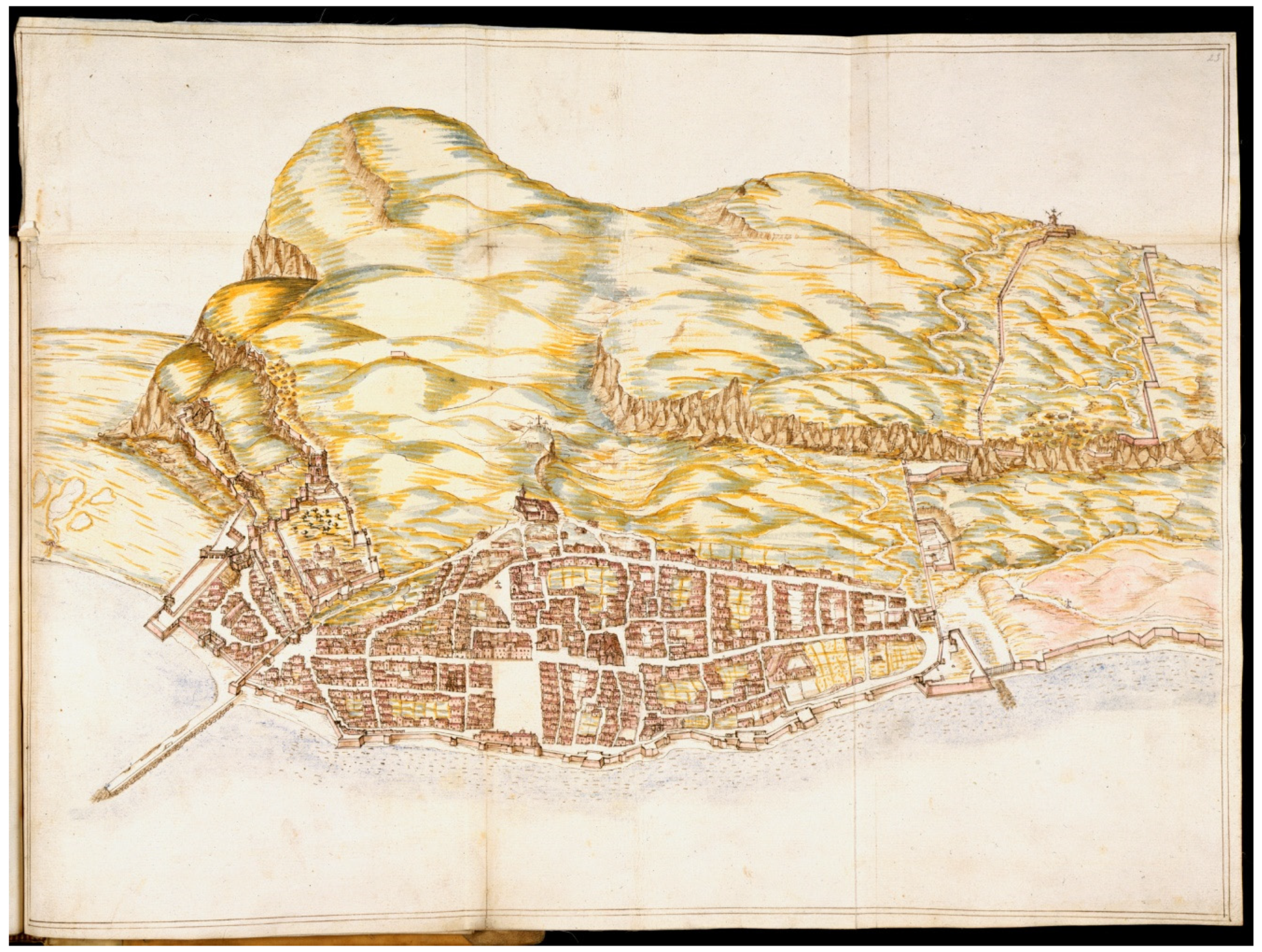


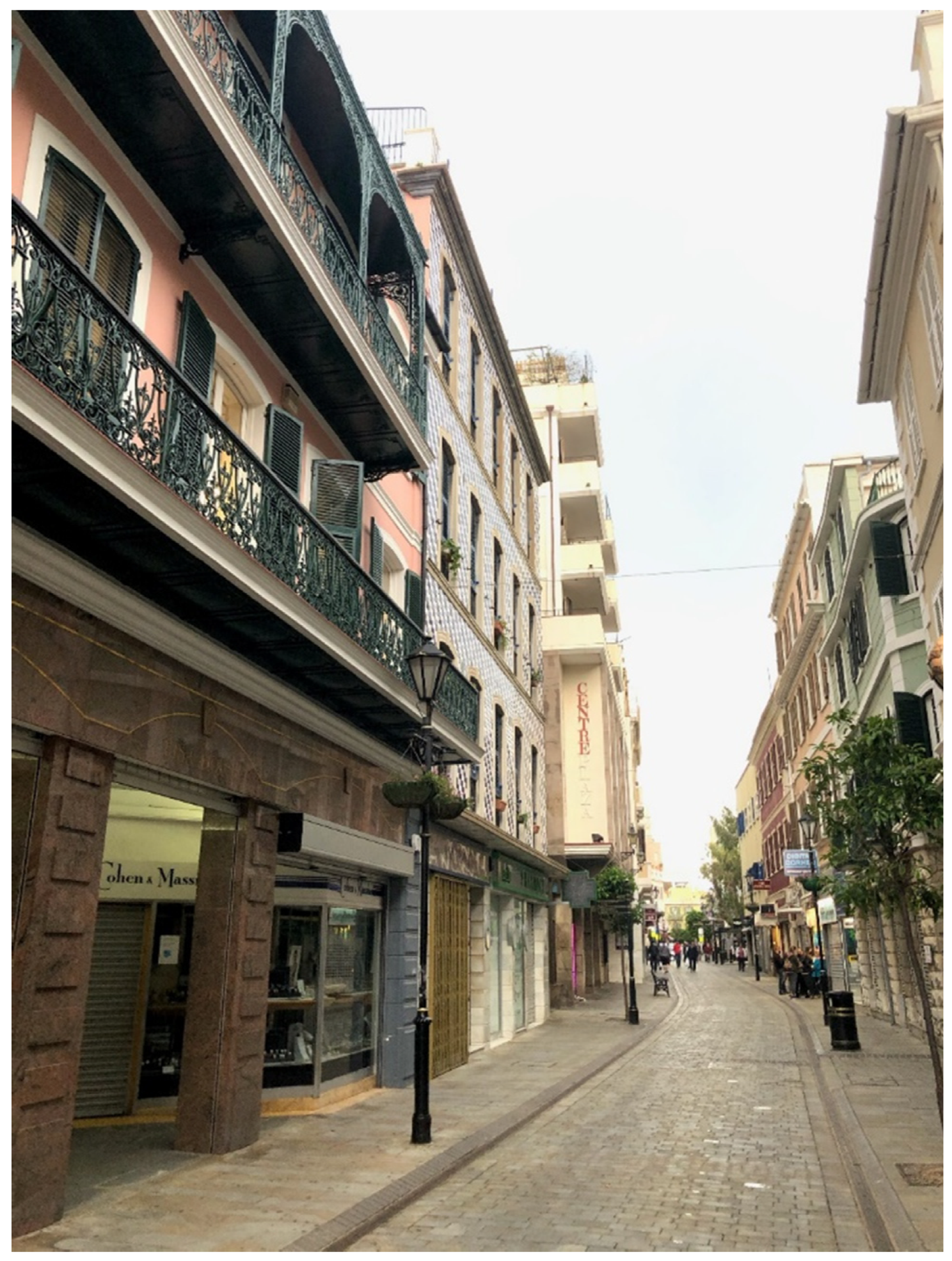
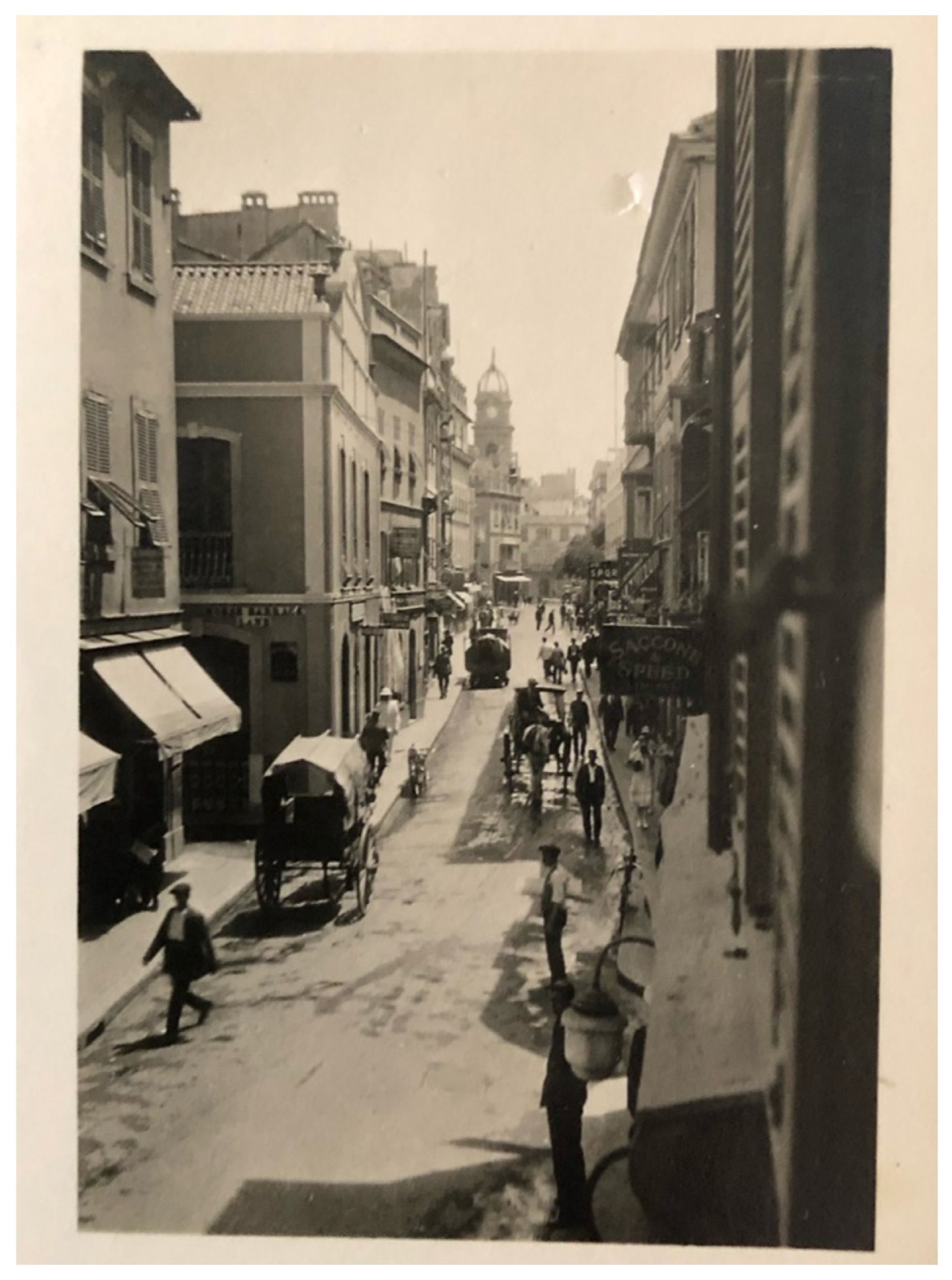
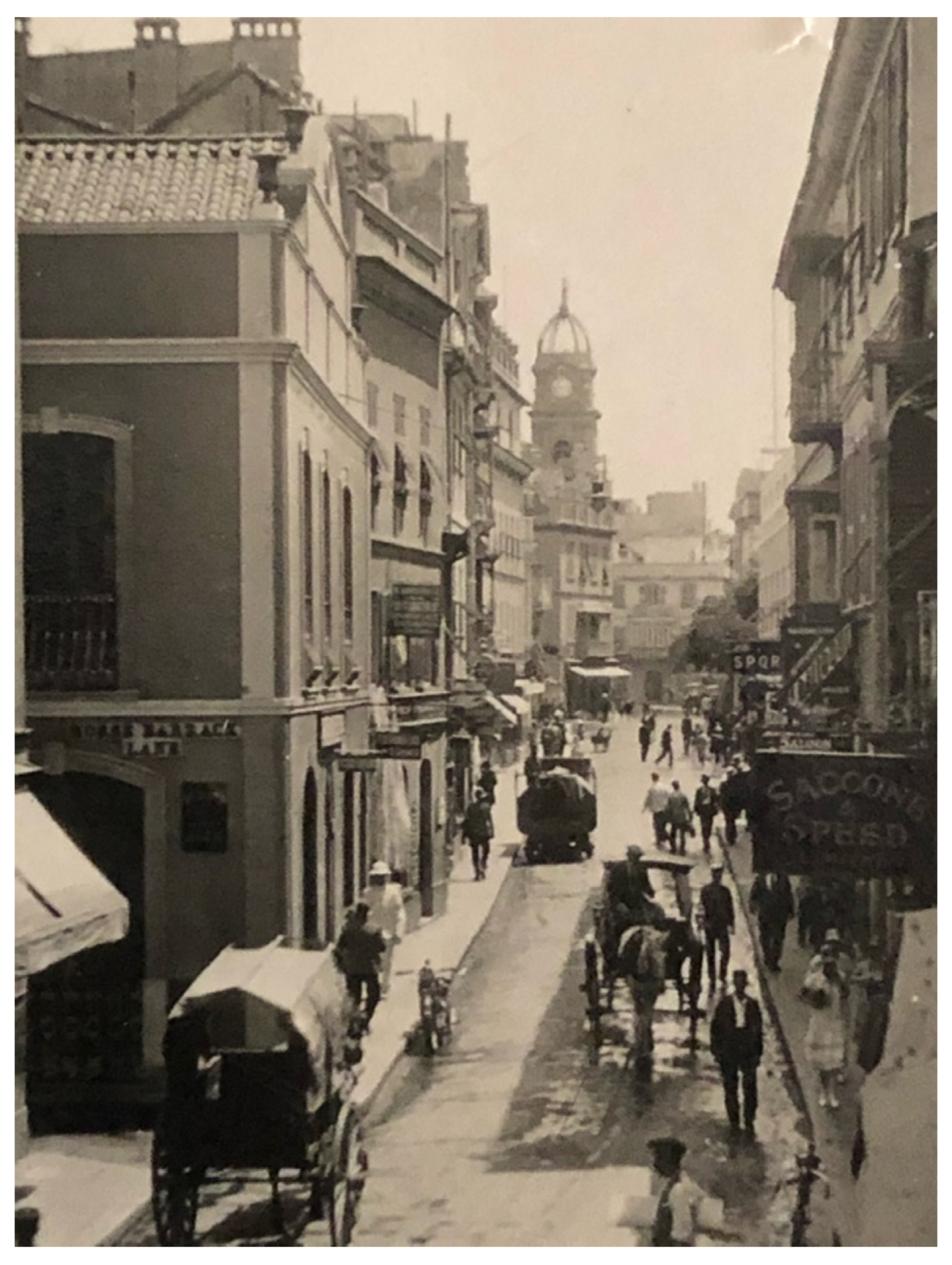
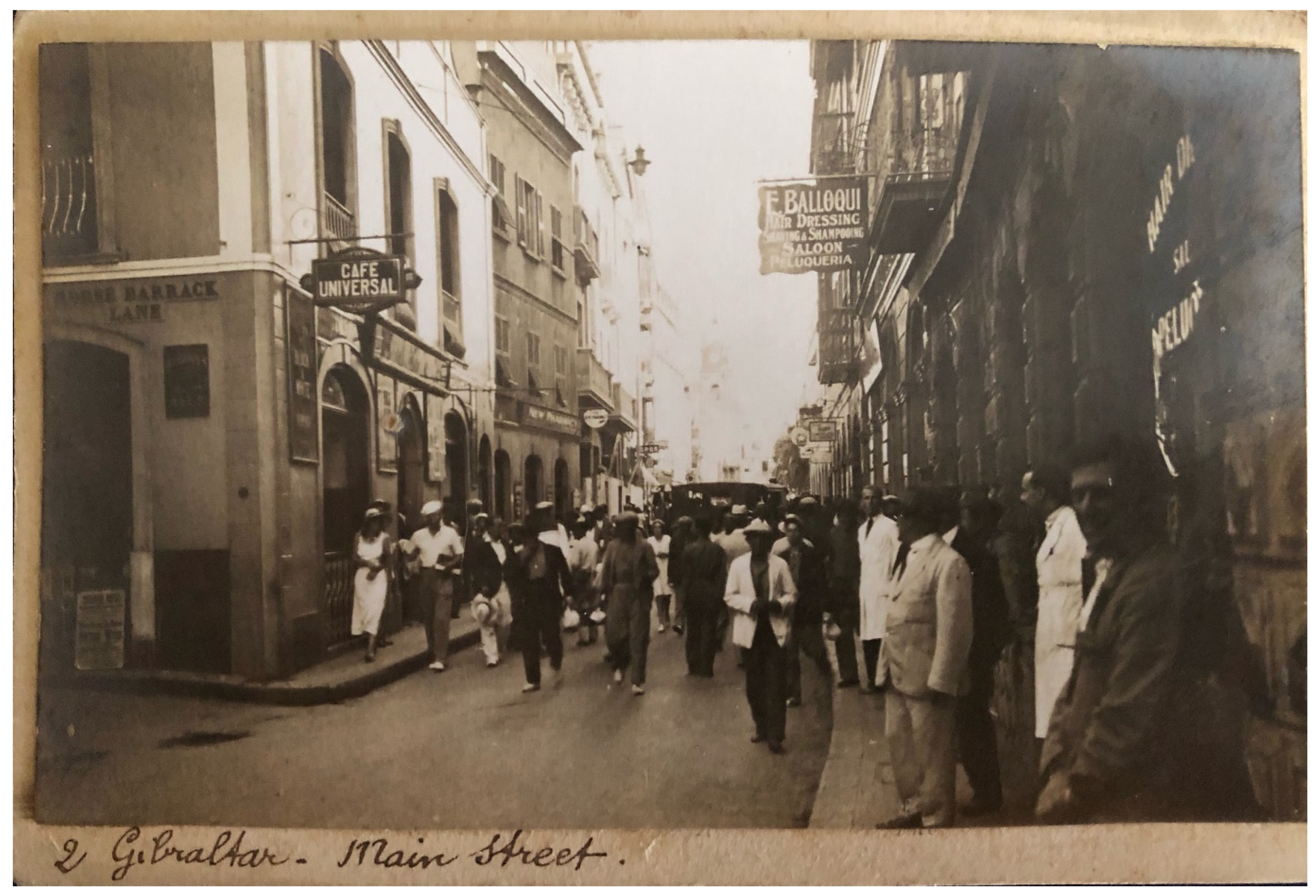




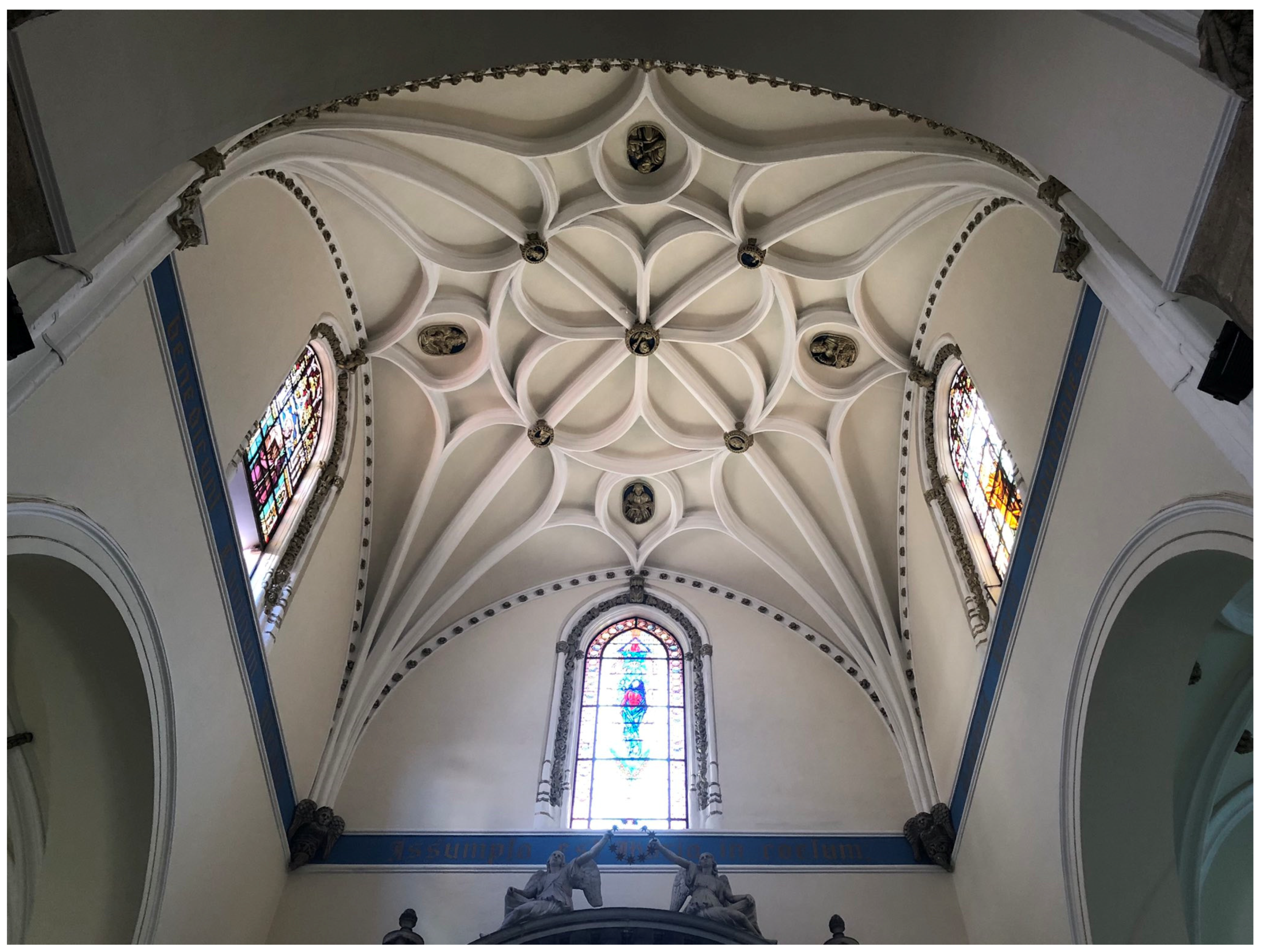
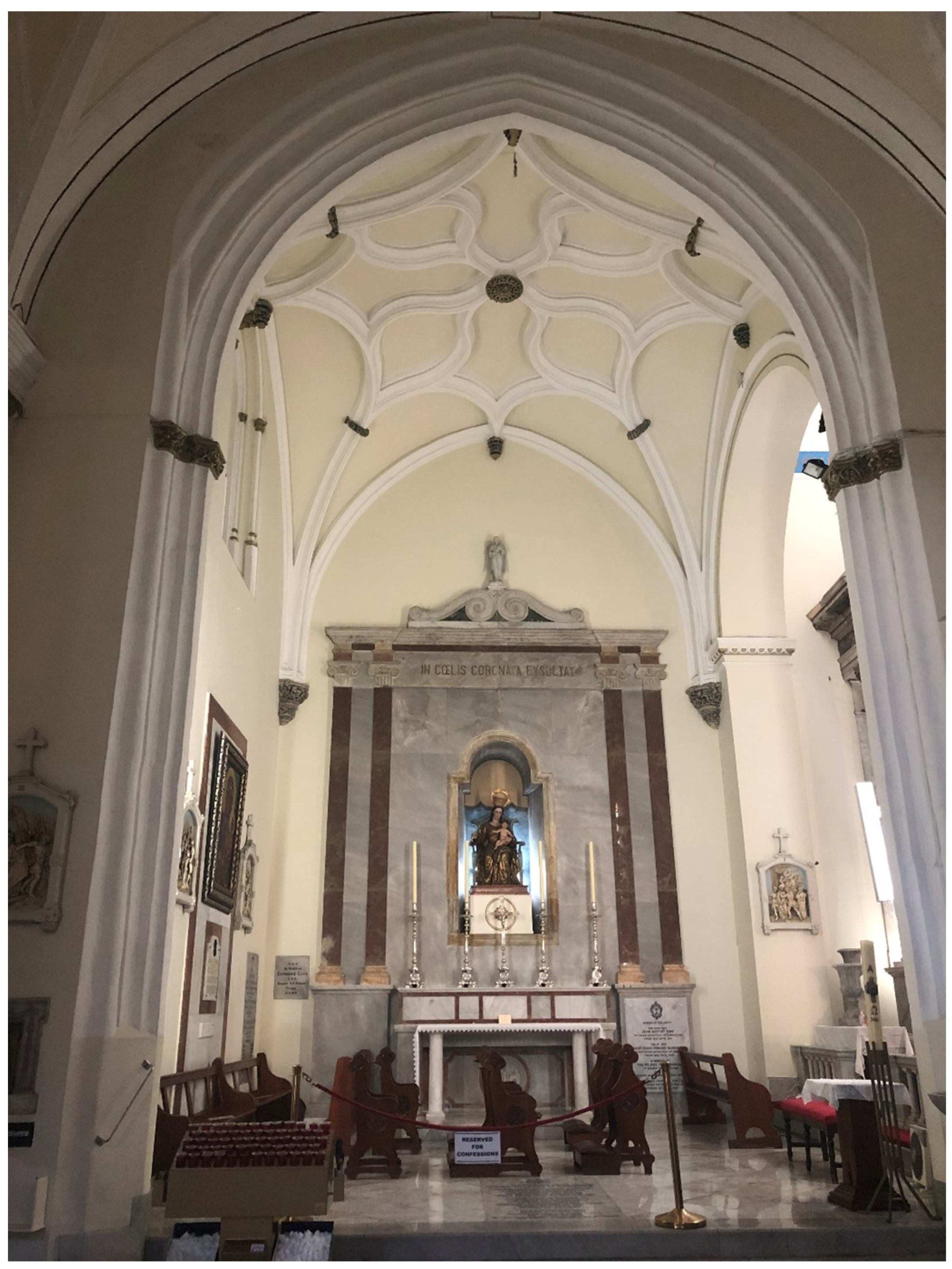
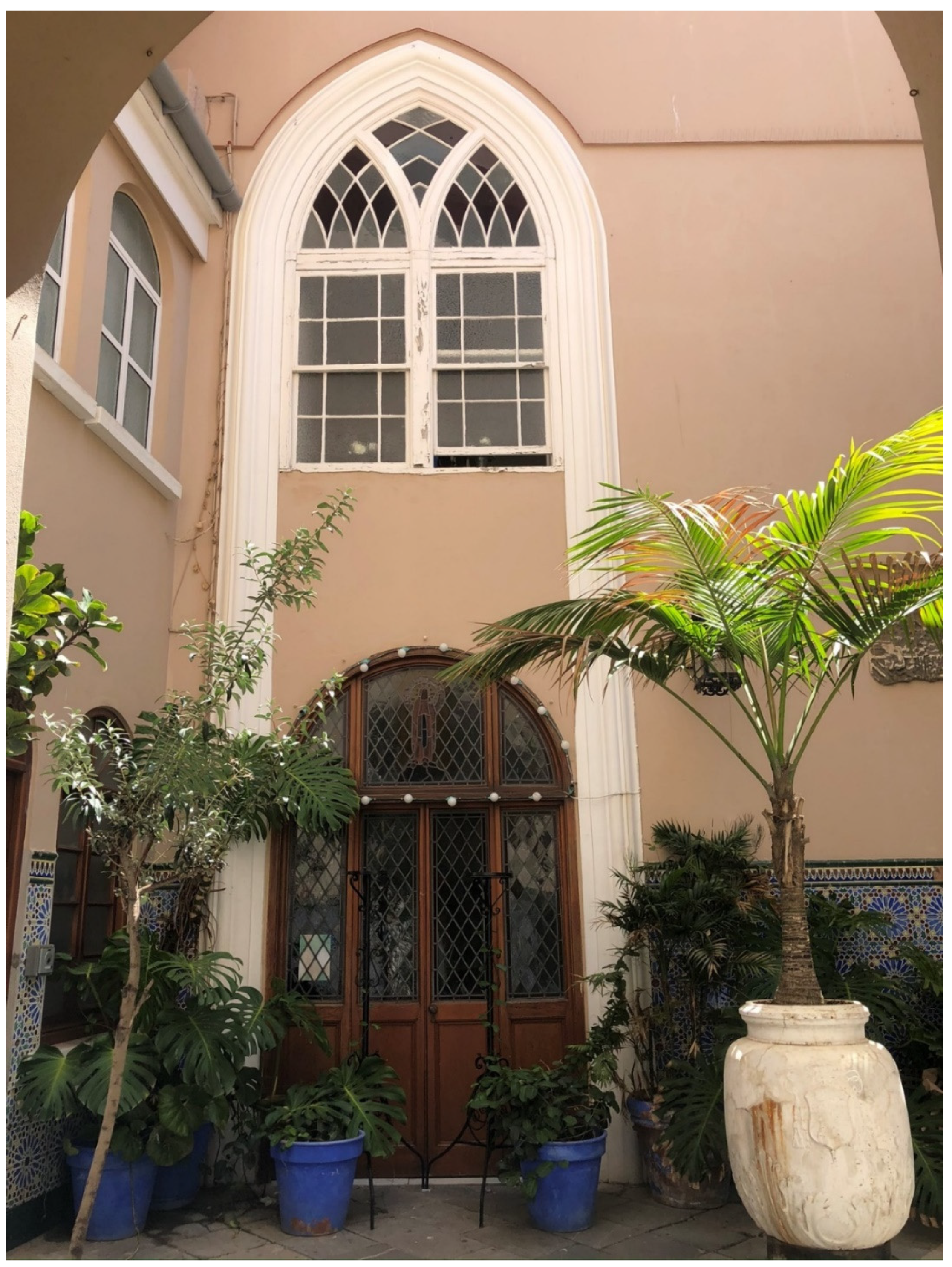
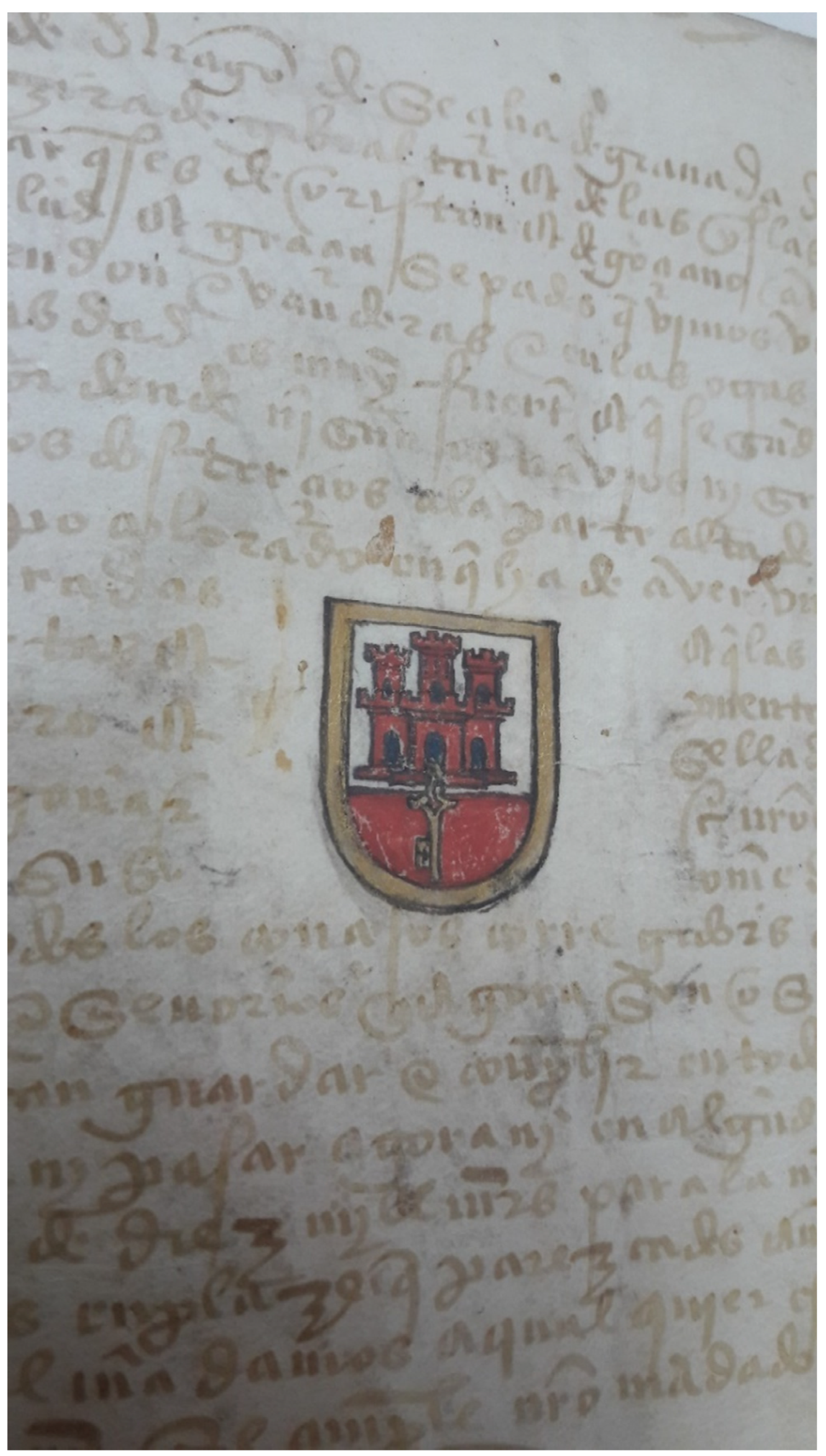
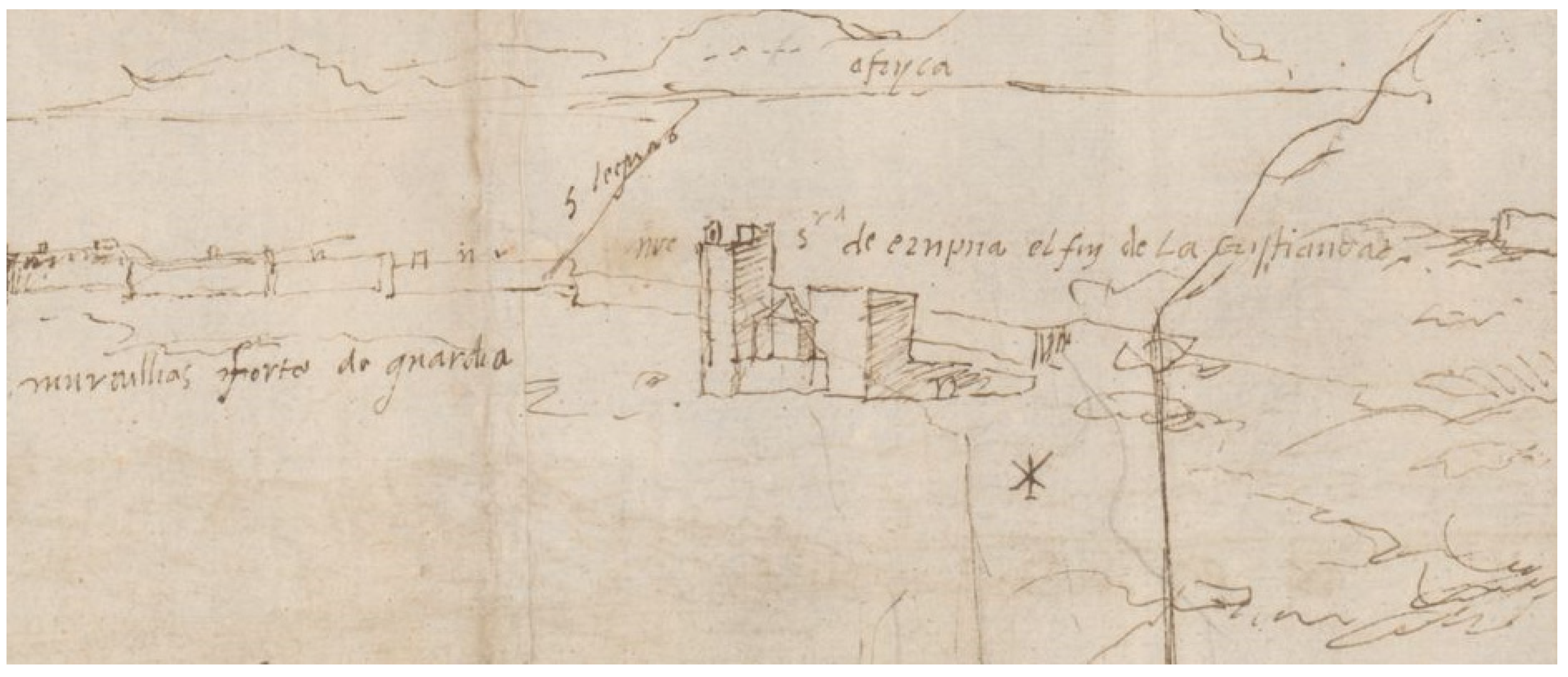

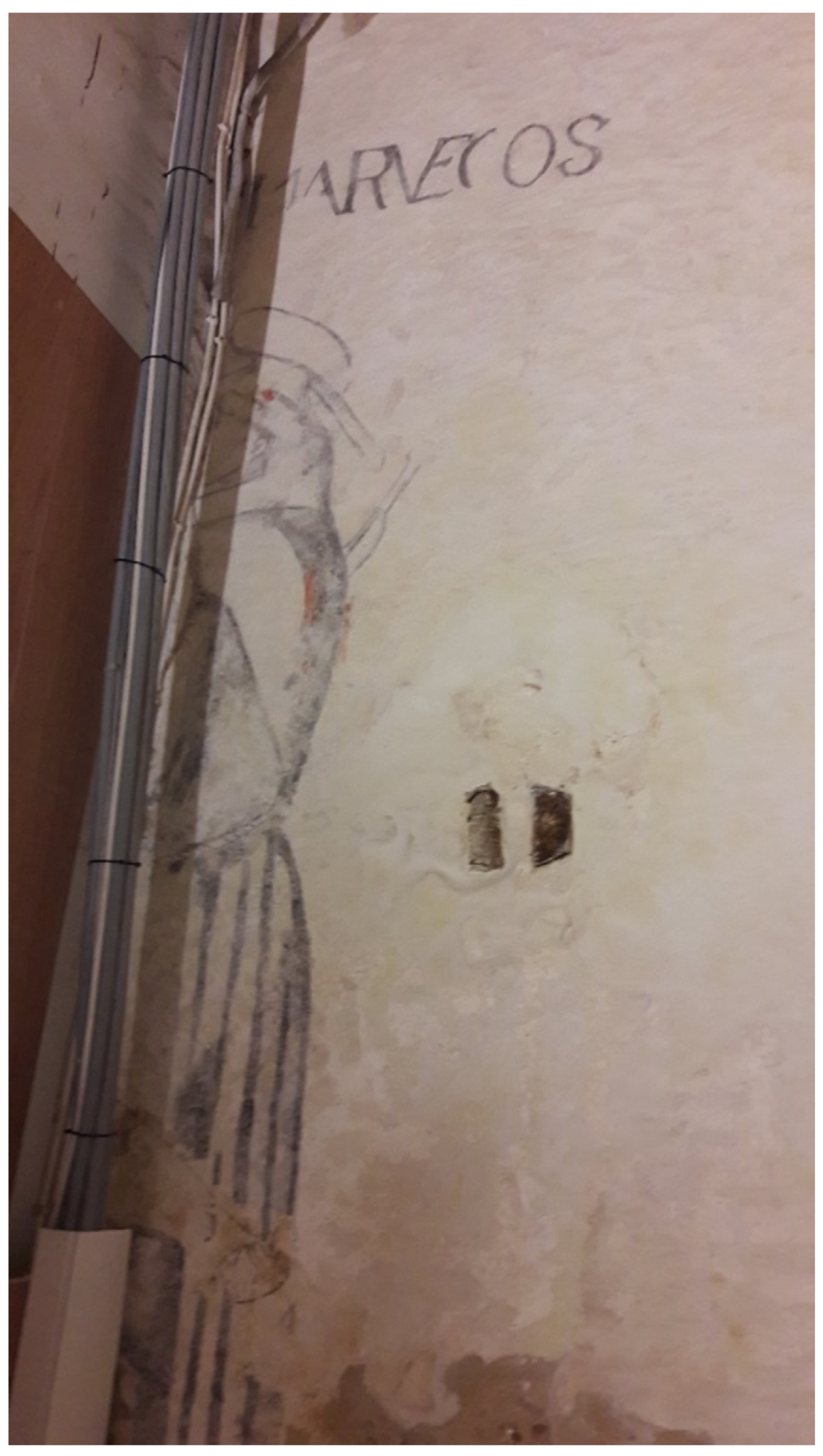
Publisher’s Note: MDPI stays neutral with regard to jurisdictional claims in published maps and institutional affiliations. |
© 2022 by the author. Licensee MDPI, Basel, Switzerland. This article is an open access article distributed under the terms and conditions of the Creative Commons Attribution (CC BY) license (https://creativecommons.org/licenses/by/4.0/).
Share and Cite
Asquez, R. La Vera Cruz: Wills, Confraternities, Catholic Reconquest and Reform in Sixteenth-Century Gibraltar. Religions 2022, 13, 710. https://doi.org/10.3390/rel13080710
Asquez R. La Vera Cruz: Wills, Confraternities, Catholic Reconquest and Reform in Sixteenth-Century Gibraltar. Religions. 2022; 13(8):710. https://doi.org/10.3390/rel13080710
Chicago/Turabian StyleAsquez, Ryan. 2022. "La Vera Cruz: Wills, Confraternities, Catholic Reconquest and Reform in Sixteenth-Century Gibraltar" Religions 13, no. 8: 710. https://doi.org/10.3390/rel13080710
APA StyleAsquez, R. (2022). La Vera Cruz: Wills, Confraternities, Catholic Reconquest and Reform in Sixteenth-Century Gibraltar. Religions, 13(8), 710. https://doi.org/10.3390/rel13080710




